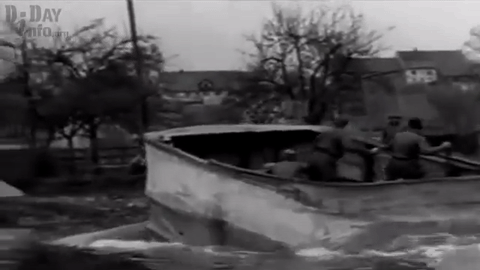I’ve often failed to appreciate just how logistically difficult war is, and how much creativity is required as constantly changing technology presents new possibilities and makes old strategies obsolete.
For example, if you want to invade heavily-fortified Nazi Europe from the water, that’s really hard! You need special boats to transport all your troops and equipment, absurdly detailed plans and coordination, and even then you can’t exactly just show up on shore and expect to walk onto land. Canadians learned devastating lessons about seaborne invasions during the Dieppe Raid in August 1942. Five thousand Canadians made up the vast majority of the invading force that day. 907 were killed, and another 2,532 were wounded or captured.
Dieppe made it clear, Mark Zuehlke writes in Juno Beach, “that infantry landing on a beach alone were easy prey.” For the massive Normandy invasion on D-Day two years later, planners wanted tanks to “set down on the beach alongside each infantry brigade to immediately destroy the beach fortifications with direct fire from the tanks’ main guns.”
Easier said than done. A similar objective at Dieppe had “failed miserably,” in part because “it was simply too easy for antitank guns mounted in fortified positions to pick off tanks trundling down the ramps of [their landing crafts] like ducks in a row.”
So, here’s an actually crazy idea: what if you had “a tank capable of swimming ashore under its own power.” Remarkably, the British invented something called a Duplex Drive tank, aka DD tank, aka Donald Duck tank. Here’s how it worked, according to Zuehlke:
The DD Tank was rendered buoyant by means of a collapsable canvass screen fitted to the hull just above the running gear. Attached to the screen were thirty-two regularly spaced tubes of four-inch diameter. When injected with compressed air, the tubes expanded like sausages, pulling the attached screen upright, with the result that the tank became completely encircled by a canvass ring steadied not only by the inflated tubes but also by eight metal braces bracketed to the hull. The screen provided sufficient displacement to keep the tank afloat even in relatively rough seas.
Having a hard time picturing this? Me too! But I have Google and I found pictures. Here is what a DD tank looked like with the canvass screen lowered:

And here is what it looked like when the screen was raised and held in place by those metal braces and tubes of compressed air:

Having a hard time picturing this floating? Me too! Let’s go to the tape:

And, from that same video, a clip of the tank driving out of the water:

You might be thinking to yourself, “wow! that looks precarious!” You would be correct.
“Although the DDs were seaworthy, they were easily swamped,” writes Zuehlke, making me question whether I really know what “seaworthy” means. “The slightest damage to the screens by enemy fire or battering by heavy surf could cause the tank to founder and sink like a stone before the crew could safely bail out.” Tank crew were therefore trained and equipped with the same kind of evacuation equipment used in submarines.
In practice, the results were mixed. The tanks were supposed to be launched 7000 yards off shore and approach inconspicuously, sitting low in the water. But the waves were much higher than anticipated, so one of the two Canadian regiments equipped with DDs, the Fort Gary Horse, brought its tanks “to within a few hundred feet of shore and let them swim from there.” The other regiment though, the 1st Hussars, launched their tanks 3000 yards from shore. Of the 29 Canadian-crewed tanks launched, 27 reached the beach.
That makes the Canadian use of DD tanks at Juno Beach significantly more successful than the American experience that same morning at Omaha Beach, where the use of the tanks is generally regarded to have been a complete disaster. The Americans stuck more closely to the plan and launched their DDs far from shore. In rough water, the majority were lost before reaching land.

Have you heard that contact form messages like these are in fact a highly effective way to generate leads for your online or offline business? How do we do this? Very simple, we put together an advertisement like the one you’re reading now for your site and we submit it to lots of contact forms on sites in whatever niche or country you want to target. Does this method of advertising work? Since you’ve ready my entire message then you’re proof that they do! The awesome thing is, you can do this for less than $25 a week! Want to find out more? send an email to: HansenAndyc65833@gmail.com